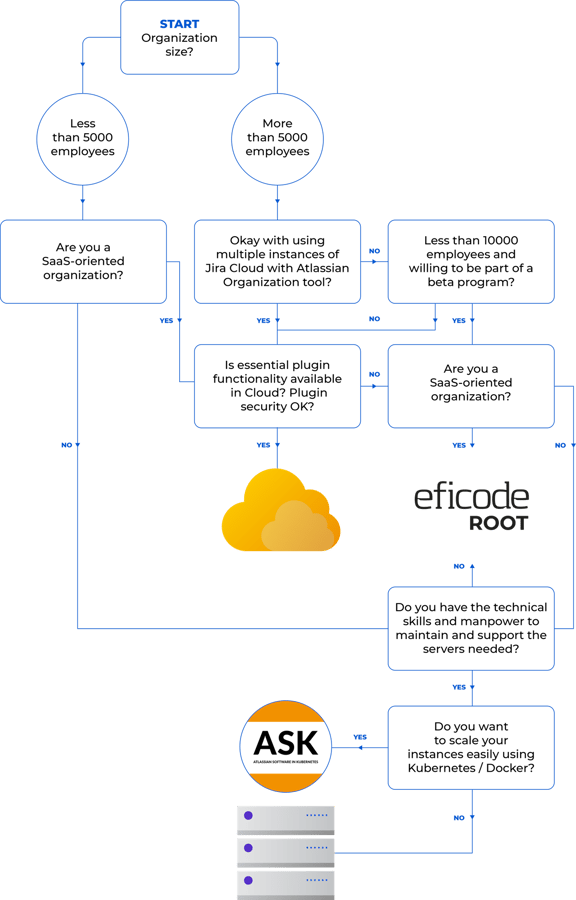Getting started with Jira Server or Jira Cloud

The Atlassian tools are the right ones for the job but you have to choose to either use Server or Cloud. We’ve got your back! Learn what to choose and why.
In this post I will help you to make the right choice based on my own practical experience as a Jira Administrator/Consultant, and on the experiences of my fellow Consultants at Eficode Praqma who helped me write this post.
This advice is for any person or team trying to make the final decision about whether to use Atlassian Cloud or Server. You might be the CTO of your company or the Administrator/Team manager and this will help you to make an informed decision.
Overview
 One of the main driving factors behind choosing a software as a service (SaaS) solution like Jira Cloud is that it offers automatic updates, low maintenance, and integrates easily with other cloud applications and systems.
One of the main driving factors behind choosing a software as a service (SaaS) solution like Jira Cloud is that it offers automatic updates, low maintenance, and integrates easily with other cloud applications and systems.
However, one thing you should keep in mind is that you do not have full control over the solution. Automatic updates are great when you receive new features with no effort. But, conversely, changes may be introduced that impact the way you work. Features or UI elements may be changed/added or removed as new updates are introduced. Currently, Atlassian is trying to roll out a new default UI which makes life a bit difficult for those who are accustomed to the functionality of the old one. It is possible to disable pr. individual user, but there is no way for you as an organization to choose not to use it.
There is also a divergence of supported features between the server and the cloud offerings. One key feature in the cloud which you will not find in Server is the Next Gen Project. Anyone in your organization can create it. The idea is to have a personalized project where the customization and configuration you create is localized to the project. It also has a roadmap feature which is very handy. However, it still seems unfinished in some ways and simple things like being able to edit the workflow is just not available in Next Gen Projects. Also, letting everyone go in their own direction may not be the best strategy in some organizations. Next Gen Projects cannot be migrated to Jira Server, so keep that in mind as well.
 The Jira Server solution offers full control and it might be easier to integrate it with your internal systems, but there are serious costs to consider regarding maintenance and updates. Full control is also a double edged sword that should be handled with care. Making small custom modifications may seem harmless at first, but remember that everything you add or change has to be maintained.
The Jira Server solution offers full control and it might be easier to integrate it with your internal systems, but there are serious costs to consider regarding maintenance and updates. Full control is also a double edged sword that should be handled with care. Making small custom modifications may seem harmless at first, but remember that everything you add or change has to be maintained.
I have seen too many real world examples of server instances being “optimized” and/or “configured” by multiple people who are no longer in the company, or are just impossible to trace. Since no one can maintain, update or explain these solutions it is impossible to predict what will happen if they update the Jira instance. As a consequence they often choose not to update the system. This is particularly problematic if they need stability, performance, or new features introduced in the new patches.
Datacenter is an identical but scalable version of Server, so I will not go into detail about it in this text. This article focuses on the main differences between Cloud and Server.
Organization size
.jpg?width=300&name=business-businessmen-classroom-communication-267507%20(1).jpg) Each cloud instance supports up to 5,000 users. There is also an early access program that promises up to 10,000 users. Yet the server version has no user limit when using Data Center. This means that larger organizations with higher numbers of users will have to accept using multiple Jira sites if they want to use Cloud. You can setup an Atlassian Organization to manage unlimited users across the sites, but each site will be on its own separate instance.
Each cloud instance supports up to 5,000 users. There is also an early access program that promises up to 10,000 users. Yet the server version has no user limit when using Data Center. This means that larger organizations with higher numbers of users will have to accept using multiple Jira sites if they want to use Cloud. You can setup an Atlassian Organization to manage unlimited users across the sites, but each site will be on its own separate instance.
Keep in mind that Jira’s reporting tools will only be able to get the view and reports from the instance they are located in. You would have to use another external tool to collect data across the instances to get a complete view.
If you are part of one of these larger organizations I would recommend the Server/Data Center. With such a large number of users it’s likely you will also have the resources necessary to operate and maintain the system, which is the next topic we will dive into.
However, if you want to use Cloud regardless then the plugin Exalate can help with Accessibility by synchronizing the issues and data between the instances.
Operations and maintenance
 Is your organization already developing code and maintaining servers or are you embracing the SaaS mindset? Maybe you are doing a bit of both? Operating and maintaining local servers can quickly become a much more costly affair than first anticipated, especially if you do not already have a dedicated and experienced team to manage it. Any updates, outage, security risk or scaling has to be performed by you or your team when using Jira Server.
Is your organization already developing code and maintaining servers or are you embracing the SaaS mindset? Maybe you are doing a bit of both? Operating and maintaining local servers can quickly become a much more costly affair than first anticipated, especially if you do not already have a dedicated and experienced team to manage it. Any updates, outage, security risk or scaling has to be performed by you or your team when using Jira Server.
If you can meet that challenge the payoff is potentially faster loading times and complete control. You could modify the instances in any way you like. However, in my opinion, the pros do not outweigh the cons.
The employees working on maintaining, updating, and scaling your system could have been used somewhere else in the company to create value. The faster loading might not even be noticeable to your users and making your own custom modifications means you have to maintain them. If maintaining and operating the instances is in any way a concern I would recommend the Cloud solution. Even if it isn’t, I would still recommend Cloud to free the extra workforce and give you the peace of mind that someone else is handling it.
In nearly every case you can use the Atlassian Marketplace to find a plugin that will do exactly what you need, so you rarely have to customize anything. That brings us to the next topic.
Plugins
.jpeg?width=300&name=close%20up%20of%20a%20puzzle%20game%20parts%20(1).jpeg) The correct plugin, and whether or not it is available for Cloud or Server, can make or break your decision.
The correct plugin, and whether or not it is available for Cloud or Server, can make or break your decision.
A couple of years ago Jira Cloud was still a relatively new product and there weren’t many plugins available. A lot of plugins had already been developed for the Server platform, but they were not compatible with Cloud. However, more and more features from the Server side are appearing on the Cloud.
Some of the commonly used plugins and how they are supported on the two platforms:
|
Plugin |
Server |
Cloud |
Description |
|
✅ |
(✅) |
Scriptrunner allows you to run Groovy Scripts on your instance to get that little extra functionality you couldn’t get anywhere else. Server version has more advanced features and there are several limitations in the Cloud like a maximum 60 second execution time. List of limitations |
|
|
✅ |
✅ |
Synchronize almost everything between multiple Jira instances. If your organization is divided into multiple Jira instances then you can still share specific templates, custom fields, or even entire projects. |
|
|
EazyBi Reports and Charts |
✅ |
(✅) |
The Business Intelligence plugin for Jira. Can be a bit complex to get started with, but it has very nice documentation and support. I have been using this a lot and it works great, but if you are doing complex calculations the plugin may time out in the Cloud. As with Scriptrunner there is a limit on the execution time of queries. If using the Cloud version they will store a copy of your data on their own servers. Consider if this is okay for your organization. |
|
✅ |
✅ |
If you are already using Microsoft's PowerBi tool for your internal business and reporting, this plugin is the one you need. Easy to set up for both Cloud and Server and you can select what data sets you want to extract from Jira. |
|
|
✅ |
✅ |
More features for the Servicedesk Portal in Jira. Allows you to hide/show other fields in your request forms based on previous input.The dynamic requests work great, but I did experience a complete day of downtime with this in the Cloud where customers were unable to submit requests. Only happened once and the support was very helpful. |
|
|
✅ |
⛔ |
Similar functionalities as the Extension for Service Desk above and the same vendor, but only available for Server/Datacenter. |
|
|
✅ |
✅ |
I have not tried this but it also supports Cloud and promises Dynamic Forms. There is even a free version though it has fewer features available. |
|
|
✅ |
✅ |
The number one diagramming tool for Jira. Allows you to insert org charts, BPMN, UML, ER diagrams, wireframes, mockups, network diagrams. Haven’t found much difference between the Cloud and Server versions. |
|
|
✅ |
✅ |
If you feel limited by the default work logs then this is the plugin for you. Should be able to support all your time tracking needs. There is a small difference in the interface of Cloud and Server, but the functionality is very similar. |
|
|
✅ |
(✅) |
Test Management tool plugin. I recommend Xray over the competitor Zephyr because it is cheaper and has better CI/CD integrations. |
|
|
✅ |
✅ |
For all of your Roadmap and Gantt Chart needs. Allows you to manage multiple projects at the same time and get a nice overview. If you are all about Agile Development then you should also consider Portfolio as an alternative to the plugin. If you have more than 500 employees in your organization you should also consider Jira Align as an alternative. |
As I mentioned above, it would be wise to consider what data from your instances is being copied to the different plugins, where this data is stored, and what the vendor provides regarding data security. Some plugins, like EazyBi, make a complete or partial copy of your data in order to manipulate it independently of your system. This data may be stored locally when using Server, but when running in the Cloud it is hosted on third party servers provided by the vendor.
As described in section 5.6. Vendor Terms in the Atlassian Marketplace Vendor Agreement the Privacy and Terms of use agreement is not provided by Atlassian but by the vendors themselves.
Unless your organization is handling private or otherwise volatile data, the benefits of using the right plugin in the Cloud and not having to worry about compatibility, updates and maintenance are always preferable compared to handling the same tasks on Server. These things can still cause problems in the Cloud environment and you may occasionally experience downtime on the plugins as they are being maintained and updated remotely, just like Jira Cloud. However, in those cases you can rest assured that the vendor and/or Atlassian is working on a solution.
The choice
If you have not already decided then I’ve prepared a small flowchart below to help you on your way.
If you want the best of both worlds then you should check out Eficode ROOT. It is specifically designed for users who want the ease of a software as a service (SaaS) where you do not have to worry about anything regarding maintenance, updates and compatibility, while still ensuring data privacy and custom functionality exactly the way you want it.
When you are using the Server/Data Center solution I would also recommend looking into Atlassian Software in Kubernetes (ASK) which will let you scale your instances using Kubernetes, Docker, and other container tools. This allows you to easily scale to the performance needed and makes it easier to get your instances up and running again if any problems occur.

Final thoughts
Finally, if for some reasons you are still in doubt and you want me to tell you what to choose, go with Cloud. A few years ago I would have suggested the Server solution due to the many limitations and configuration challenges I ran into without plugin support or integration with other on premise solutions. But most of those problems are no longer there with Cloud. I strongly dislike the way the new UI for Cloud was set as default for new users, but I still have to recommend it given all the other advantages. My impression is that Atlassian, and almost every other organization who has the choice, wants to develop and provide their software in the Cloud. You are likely to be left behind in a couple of years when everything is running as a service in the cloud.
Thank you for joining me on this journey through Server and Cloud. If you have any questions or want more information then you are welcome to contact me.
Published:
Updated:


